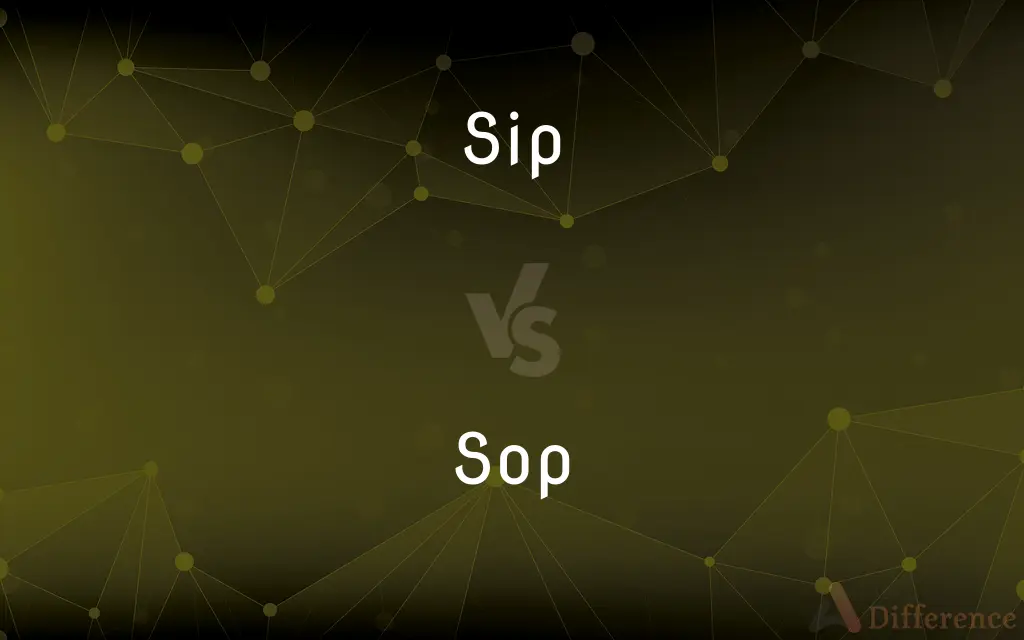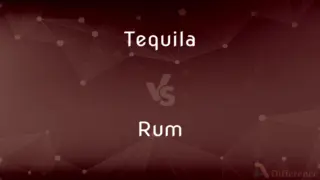Sip vs. Sop — What's the Difference?
By Maham Liaqat & Fiza Rafique — Updated on March 28, 2024
"Sip" refers to drinking a small amount of liquid gently, while "sop" involves absorbing liquid with a piece of solid food.

Difference Between Sip and Sop
Table of Contents
ADVERTISEMENT
Key Differences
Sipping is a method of drinking that involves taking in a small amount of liquid at a time, usually in a slow and careful manner. It is often associated with the enjoyment of the beverage, allowing one to taste and savor the flavor fully. Sipping is common with hot beverages like tea or coffee, or when tasting wines and spirits, where the focus is on the sensory experience. On the other hand, sopping involves using a piece of solid food to absorb liquid. It is a way of combining food and liquid to enhance flavor or to make the food easier to eat. For example, bread is often used to sop up sauces or broths, adding to the dish's overall taste and texture.
Sipping is considered a more delicate and refined action, often associated with social norms and etiquette. It signifies taking one's time, possibly in a social setting or for personal enjoyment. Conversely, sopping is a more utilitarian action, focusing on not wasting the liquid part of a meal or enhancing the food's moisture and flavor. It can be seen as a hearty and more informal way of eating, deeply rooted in various cultures and cuisines.
Both actions serve different purposes and contexts in dining and drinking experiences. While sipping allows for a gradual enjoyment and appreciation of beverages, sopping enhances the culinary experience by merging the textures and flavors of both solid and liquid elements. These methods highlight different aspects of taste and consumption, reflecting personal or cultural preferences.
While sipping is primarily a solitary action focused on the drinker's interaction with their beverage, sopping is often communal, shared around a meal table. Sopping can be part of a meal's ritual, signifying abundance and the pleasure of eating together. In contrast, sipping can be a personal moment of relaxation or contemplation.
Though distinct in their purposes and methods, both sipping and sopping are acts of consumption that enhance the sensory experience of eating and drinking. They reflect the diversity of ways in which food and drink can be enjoyed, catering to different tastes, textures, and traditions.
ADVERTISEMENT
Comparison Chart
Definition
To drink a small amount of liquid gently.
To absorb liquid with a piece of solid food.
Associated Action
Drinking
Eating
Purpose
To taste and savor the beverage.
To enhance flavor or ease of eating.
Common Context
Enjoying beverages, tasting.
Eating meals with sauces or broths.
Cultural Aspect
Associated with etiquette and refinement.
Often seen in communal eating settings.
Compare with Definitions
Sip
A delicate way of drinking.
With a sip, she enjoyed the warm coffee on a cold morning.
Sop
To soak up liquid with food.
He used a piece of bread to sop up the remaining sauce.
Sip
A method of tasting and enjoying a drink.
He took a sip of wine to savor its flavor.
Sop
Eating food that has absorbed liquid.
They enjoyed sopping up the soup with fresh bread.
Sip
Drinking slowly.
He took a sip of water between conversations.
Sop
A method to not waste liquid in a dish.
Sopping up the stew with bread ensured nothing was wasted.
Sip
To drink in small mouthfuls.
She took a sip of her tea to avoid burning her tongue.
Sop
Combining food with liquid for flavor.
She sopped her biscuit in gravy for extra taste.
Sip
Enjoying a beverage in small amounts.
They took sips of their drinks while watching the sunset.
Sop
Enhancing the meal's moisture.
Sopping the dry cake in syrup made it much more enjoyable.
Sip
To drink in small quantities.
Sop
A sop is a piece of bread or toast that is drenched in liquid and then eaten. In medieval cuisine, sops were very common; they were served with broth, soup, or wine and then picked apart into smaller pieces to soak in the liquid.
Sip
To drink from in sips.
Sop
To dip, soak, or drench in a liquid; saturate.
Sip
To drink something in sips.
Sop
To take up by absorption
Sop up water with a paper towel.
Sip
The act of sipping.
Sop
A piece of food soaked or dipped in a liquid.
Sip
A small quantity of liquid sipped.
Sop
Something yielded to placate or soothe
Remarks that were a sop to conservative voters.
Sip
A small mouthful of drink
Sop
A bribe.
Sip
(transitive) To drink slowly, small mouthfuls at a time.
Sop
Something entirely soaked.
Sip
(intransitive) To drink a small quantity.
Sop
A piece of solid food to be soaked in liquid food.
Sip
To taste the liquor of; to drink out of.
Sop
Something given or done to pacify or bribe.
Sip
Alternative form of seep
Sop
A weak, easily frightened or ineffectual person; a milksop
Sip
(figurative) To consume slowly.
Sop
(Appalachian) Gravy.
Sip
To drink or imbibe in small quantities; especially, to take in with the lips in small quantities, as a liquid; as, to sip tea.
Sop
(obsolete) A thing of little or no value.
Sip
To draw into the mouth; to suck up; as, a bee sips nectar from the flowers.
Sop
A piece of turf placed in the road as a target for a throw in road bowling.
Sip
To taste the liquor of; to drink out of.
They skim the floods, and sip the purple flowers.
Sop
(transitive) To steep or dip in any liquid.
Sip
To drink a small quantity; to take a fluid with the lips; to take a sip or sips of something.
[She] raised it to her mouth with sober grace;Then, sipping, offered to the next in place.
Sop
(intransitive) To soak in, or be soaked; to percolate.
Sip
The act of sipping; the taking of a liquid with the lips.
Sop
Anything steeped, or dipped and softened, in any liquid; especially, something dipped in broth or liquid food, and intended to be eaten.
He it is to whom I shall give a sop, when I have dipped it.
Sops in wine, quantity, inebriate more than wine itself.
The bounded watersShould lift their bosoms higher than the shores,And make a sop of all this solid globe.
Sip
A small draught taken with the lips; a slight taste.
One sip of thisWill bathe the drooping spirits in delightBeyond the bliss of dreams.
A sip is all that the public ever care to take from reservoirs of abstract philosophy.
Sop
Anything given to pacify; - so called from the sop given to Cerberus, as related in mythology.
All nature is cured with a sop.
Sip
A small drink
Sop
A thing of little or no value.
Garlands of roses and sops in wine.
Sip
Drink in sips;
She was sipping her tea
Sop
To steep or dip in any liquid.
Sop
Piece of solid food for dipping in a liquid
Sop
A concession given to mollify or placate;
The offer was a sop to my feelings
Sop
A prescribed procedure to be followed routinely;
Rote memorization has been the educator's standard operating procedure for centuries
Sop
Give a conciliatory gift or bribe to
Sop
Be or become thoroughly soaked or saturated with a liquid
Sop
Dip into liquid;
Sop bread into the sauce
Sop
Mop so as to leave a semi-dry surface;
Swab the floors
Sop
Become thoroughly soaked or saturated with liquid
Sop
Cover with liquid; pour liquid onto;
Souse water on his hot face
Common Curiosities
How do sipping and sopping enhance the dining experience?
Sipping enhances the dining experience by allowing the individual to savor and enjoy the flavors of their drink slowly, while sopping combines the textures and tastes of food and liquid for a fuller sensory experience.
Can you sip any type of beverage?
Yes, you can sip any type of beverage, though sipping is most commonly associated with hot drinks or alcoholic beverages meant to be savored.
Are there specific foods meant for sopping?
Yes, foods like bread, biscuits, or rice are often used to sop up sauces, soups, or stews because of their absorbent nature.
Does sopping change the texture of the food?
Yes, sopping changes the texture of the food, making it softer and often easier to eat by absorbing the liquid.
What does it mean to sip a drink?
Sipping a drink means to consume it in small, gentle mouthfuls, often to better enjoy or taste the beverage.
What is the purpose of sopping food?
The purpose of sopping food is to absorb liquid, enhancing the food's flavor or making it easier to consume.
Is sopping considered good etiquette?
Sopping can vary in acceptance depending on cultural norms; in some cuisines, it is a cherished part of the meal, while in others, it might be seen as less formal.
Can sipping be part of a social ritual?
Yes, sipping can be a significant part of social rituals, such as tea ceremonies or toasts, emphasizing leisure and community.
Can sipping help in appreciating the quality of beverages?
Absolutely, sipping is a key part of tasting practices, such as in wine or coffee tastings, where the goal is to fully appreciate the beverage's flavors and aromas.
Is there a right way to sip or sop?
While there are no strict rules, culturally specific practices may guide how and when to appropriately sip or sop.
How does the texture of food affect its ability to sop?
The more absorbent a food is, the better it can sop up liquids, making softer, porous foods like bread ideal for the task.
Can sipping and sopping be seen in all cultures?
Variations of sipping and sopping can be found across many cultures, each with its own traditional beverages and meals suited to these actions.
Why might someone choose to sip rather than drink normally?
Someone might choose to sip to better enjoy the flavor of the drink, to moderate intake, or to avoid discomfort from consuming hot beverages.
What makes a liquid suitable for sopping?
Liquids that are flavorful and complement the food, such as broths, sauces, or gravies, are suitable for sopping.
How do sipping and sopping contribute to food waste reduction?
Sopping ensures that all parts of a meal, including the liquid, are consumed, reducing waste, while sipping allows for moderate consumption of beverages.
Share Your Discovery

Previous Comparison
Account vs. Narrative
Next Comparison
Tequila vs. RumAuthor Spotlight
Written by
Maham LiaqatCo-written by
Fiza RafiqueFiza Rafique is a skilled content writer at AskDifference.com, where she meticulously refines and enhances written pieces. Drawing from her vast editorial expertise, Fiza ensures clarity, accuracy, and precision in every article. Passionate about language, she continually seeks to elevate the quality of content for readers worldwide.














































